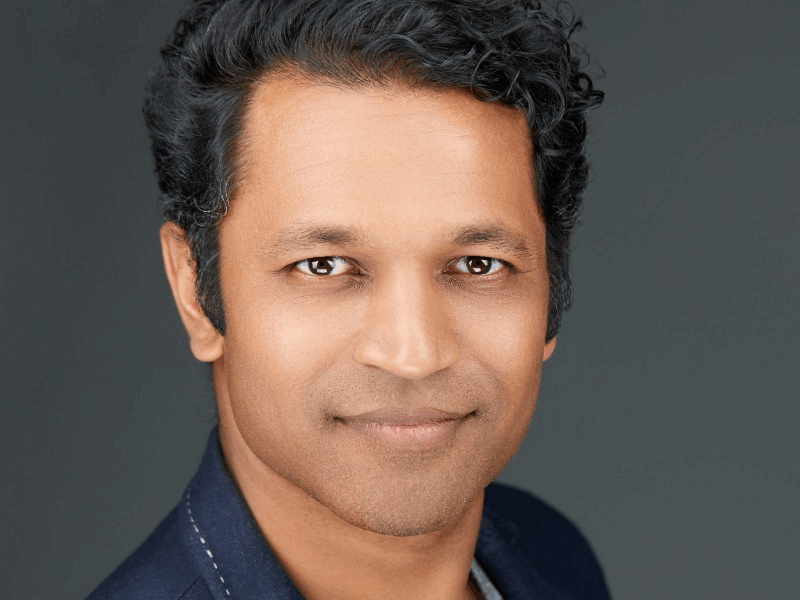Your cart is currently empty!
Blog
-
The Art of Moderation: Why It’s Crucial for Impromptu Speaking Events
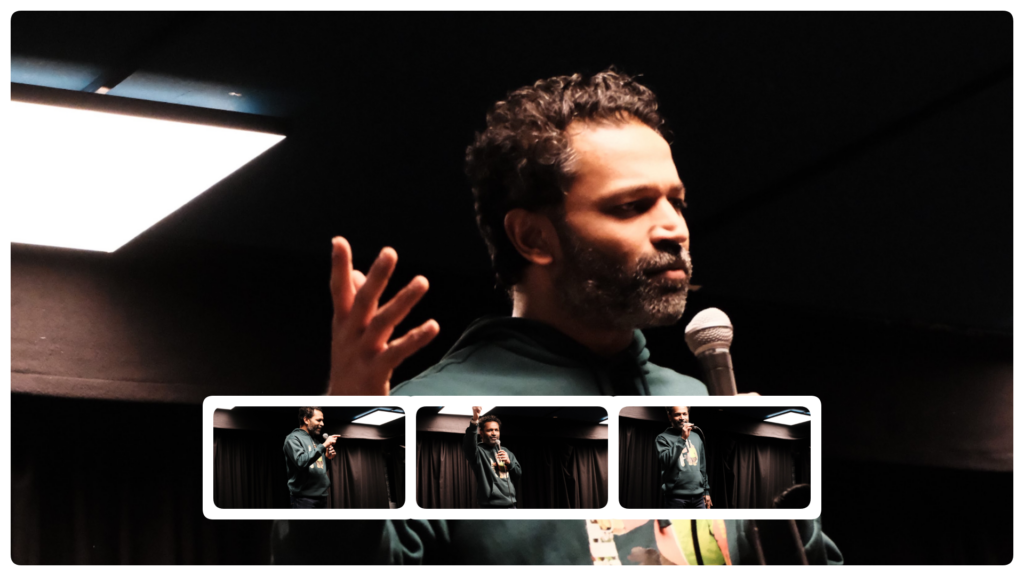
Hosting events, especially impromptu speaking sessions, requires moderation to ensure a smooth and successful experience. While often overlooked, a moderator’s role is pivotal in balancing spontaneity with structure, creating a supportive and engaging atmosphere.
The Role of a Moderator
Moderators are the anchors of events, ensuring transitions, maintaining schedules, and fostering inclusivity. In impromptu speaking, their role becomes even more nuanced:
- Setting the Tone: Establishing expectations, energizing the room, and making participants feel at ease.
- Encouraging Participation: Supporting nervous participants, breaking the ice, and fostering a welcoming environment.
- Maintaining Focus: Ensuring adherence to time limits and refocusing the session when necessary.
- Handling Challenges: Addressing unexpected situations like awkward pauses or overly enthusiastic participants with poise.
Why Moderation Matters
Impromptu speaking thrives on energy and spontaneity, but challenges like dominant speakers or digressions can arise. Here’s why moderation is essential:
- Balancing Voices: Ensuring everyone has a fair chance to contribute, promoting inclusivity.
- Encouraging Feedback: Guiding constructive feedback that uplifts and informs participants.
- Building Momentum: Seamless transitions and high energy keep the audience engaged.
Lessons from Moderating Impromptu Sessions
As one of four moderators for impromptu speaking sessions, I witnessed firsthand the importance of teamwork and adaptability. Encouraging nervous speakers, navigating unexpected moments, and maintaining audience engagement were integral to the role. Each moderator’s unique strengths contributed to a dynamic environment where participants felt empowered to embrace spontaneity and shine.
Interested in having a moderator for your next event?
Contact Ranjith at +4916092790039 or ranjith.venkatesh@mossandlichens.com
-
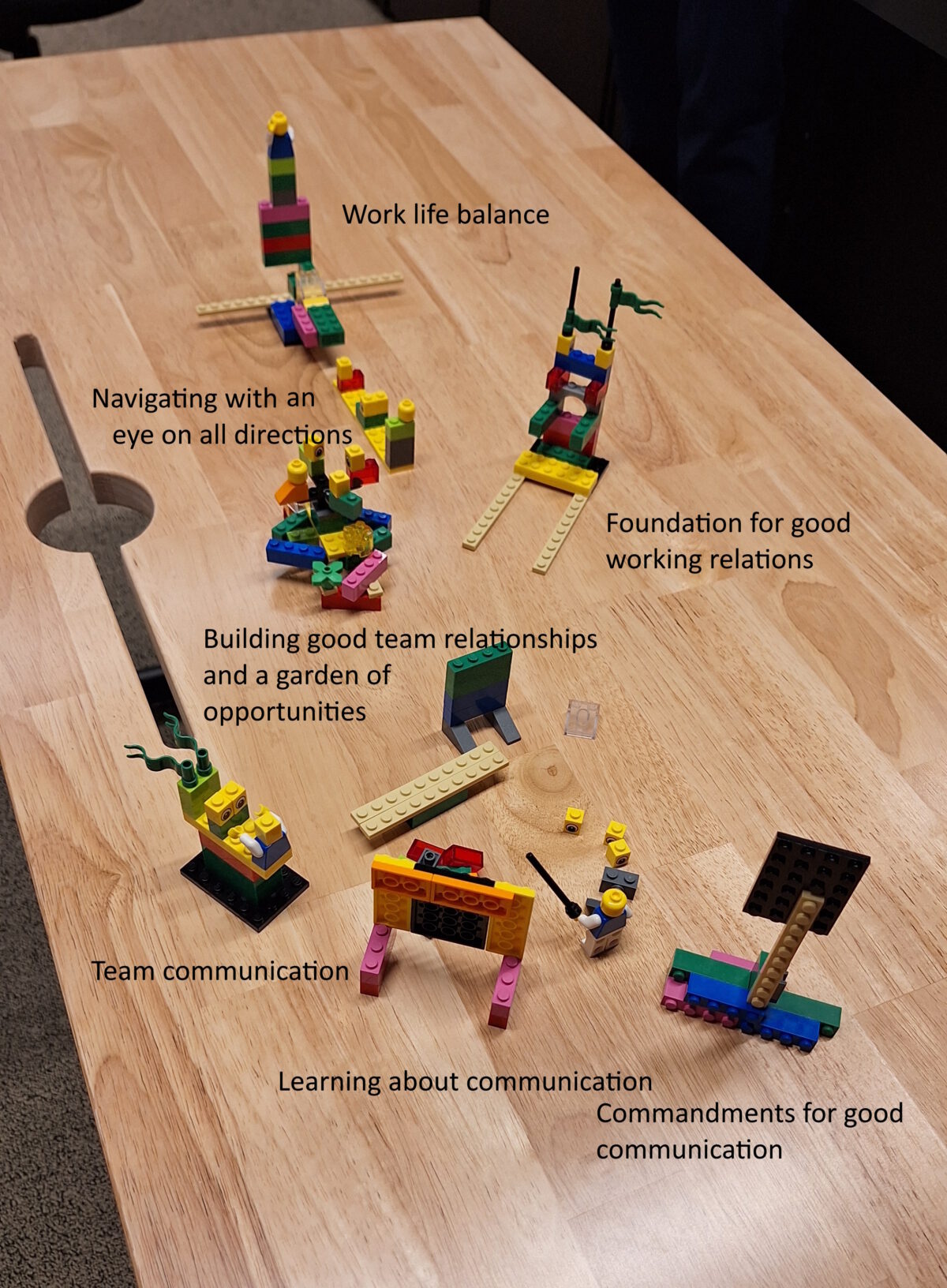
Lego Serious Play
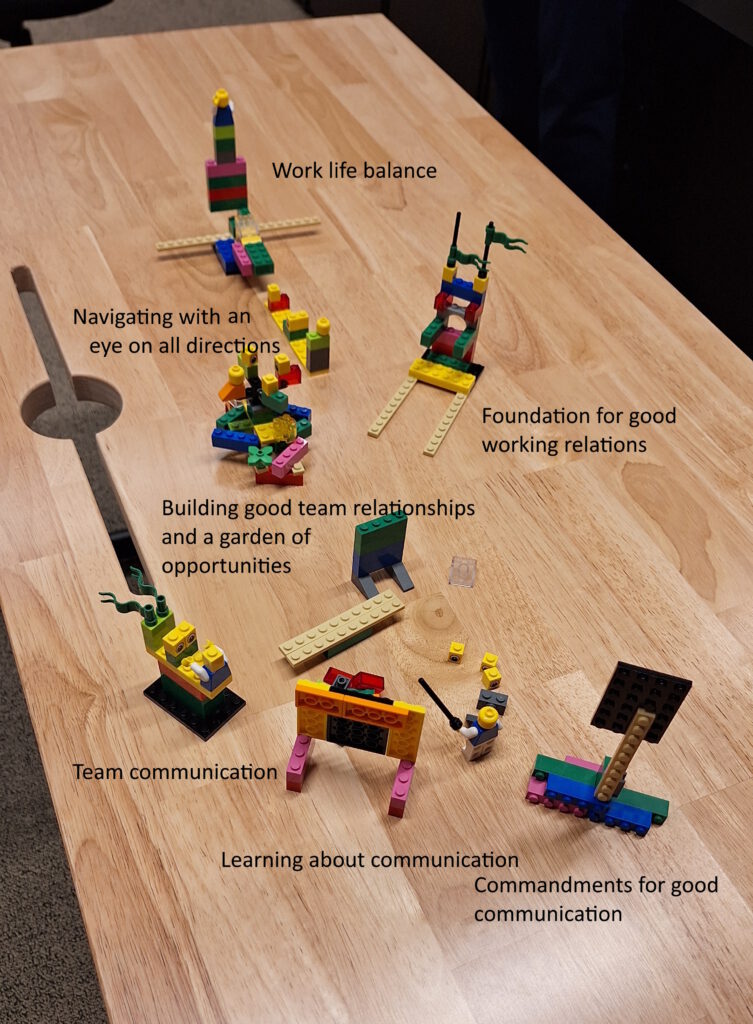
Round 4 with a group of people meeting for the first time in a meetup in Munich on 18 January, 2025
I was impressed with a few things in Lego Serious Play:
- All you need is a table, chair and bag of lego pieces to get going
- A good moderator who can create a psychologically safe space
- A nice set of exercises and GO!
I have been playing around with Liberating Structures and Management 3.0 moderation techniques. It was nice to see another moderation technique which is being used by big companies to solve complex issues.
And Matthias from Brickolution did a great job giving us an introduction to Lego Serious Play!
Links:
LEGO® SERIOUS PLAY® | Offizieller LEGO® Shop DE
-
How to Write a Speech: 3 Effective Methods with Examples and Tips for Business

Photo by Unseen Studio on Unsplash Crafting a compelling business speech is essential whether you’re delivering a presentation to clients, motivating a team, or pitching a new idea. A well-structured speech can convey confidence, professionalism, and persuasion. This guide covers three effective methods for writing impactful speeches, along with practical examples and tips, with a specific focus on business communication.
Method 1: The Problem-Solution Approach
This approach is highly effective in business settings where you need to solve a problem, pitch a product, or present a strategy. It allows you to engage your audience by identifying a challenge and offering a clear solution.
Steps:
- Identify the Problem: Begin by outlining a problem or challenge your audience faces. Make it relatable and ensure it connects with their needs or concerns.
- Present the Solution: Offer your solution with supporting evidence, facts, or success stories to prove its effectiveness.
- Call to Action: Conclude by urging the audience to take specific actions based on your solution, whether it’s adopting a new strategy, investing in your idea, or implementing a change.
Example:
Problem: “In today’s competitive market, many companies struggle to retain top talent, resulting in high turnover rates and loss of productivity.”
Solution: “Research shows that companies with robust employee engagement programs reduce turnover by up to 25%. By implementing recognition and development initiatives, we can boost morale and retention.”
Call to Action: “Let’s start by introducing a recognition program next quarter to not only retain our employees but also increase productivity.”Tips:
- Make sure the problem is relevant and pressing for your audience.
- Use data and case studies to back up your solution.
- Keep the call to action clear and actionable to drive your message home.
Method 2: The Pathos, Ethos, and Logos Approach (Persuasive Speaking)
This classical method, rooted in rhetoric, is highly effective for business speeches where you need to persuade stakeholders, clients, or employees. It engages the audience on emotional, logical, and ethical levels to deliver a convincing argument.
Steps:
- Pathos (Appeal to Emotion): Start by connecting emotionally with your audience. Use a personal story, a vivid example, or a situation that stirs their emotions, making them care about your message.
- Ethos (Establish Credibility): Establish your authority or credibility by mentioning your experience, sharing testimonials, or citing respected sources. This builds trust in you as a speaker.
- Logos (Appeal to Logic): Use facts, figures, statistics, and logical arguments to support your key message. This makes your solution or idea feel rational and feasible.
Example:
Pathos: “Picture this: a talented employee leaves your company, not because of salary, but because they didn’t feel valued. It’s a scenario too many businesses face today.”
Ethos: “As a leadership consultant with over a decade of experience helping companies boost employee retention, I’ve seen firsthand how recognition transforms workplace culture.”
Logos: “Studies show that companies with strong recognition programs see a 15% increase in employee engagement and a 12% rise in productivity. By investing in these initiatives, we can prevent turnover and create a high-performing team.”Tips:
- Use Pathos to create an emotional hook right from the beginning.
- Keep Ethos subtle but strong, showing authority without sounding self-promotional.
- Ground your speech in Logos with clear data, ensuring your message feels both emotional and rational.
Method 3: The Classic Structure (Introduction, Body, Conclusion)
This traditional method is ideal for business presentations, where clarity and logical flow are essential. It provides a well-organized framework to deliver key messages in a structured way, making it easy for your audience to follow.
Steps:
- Introduction: Start with a strong hook to capture attention. Introduce your main idea or theme.
- Body: Break down your speech into 2-3 main points. Each point should be clearly articulated and supported with facts, examples, or anecdotes.
- Conclusion: Summarize your main points and end with a strong, memorable closing statement—something that leaves the audience thinking or inspires action.
Example:
Introduction: Good afternoon, everyone. Today, I’d like to talk about a crucial factor that often goes unnoticed in business: employee well-being and its impact on company success.
Body:- Point 1: How employee well-being boosts productivity.
- Point 2: The connection between well-being programs and employee retention.
- Point 3: Practical strategies we can implement immediately to improve well-being.
Conclusion:
Investing in employee well-being isn’t just the right thing to do—it’s a smart business decision that will drive long-term success. Let’s commit to creating a healthier, more productive workplace starting today.
Tips:
- Keep your introduction clear and engaging, hinting at the value the audience will gain from your speech.
- Use transitions to move smoothly between each main point in the body.
- Finish with a powerful conclusion to reinforce your message.
Additional Tips for Business Speechwriting
- Know Your Audience: Tailor your speech to the specific needs, interests, and concerns of your audience. Are they executives, clients, or team members? Adjust your tone, content, and delivery style accordingly.
- Keep It Concise: In business, time is valuable. Ensure your speech is focused and to the point. Avoid going off on tangents or adding unnecessary details.
- Use Clear, Professional Language: Avoid jargon, complex terminology, or overly technical language unless you’re speaking to an audience that is familiar with it. Clarity is key in business communication.
- Practice Delivery: Rehearse your speech multiple times before delivering it. This will help you identify areas where you can improve clarity, pacing, and delivery. Practice in front of colleagues or friends to get feedback.
- Engage with Your Audience: Ask questions, even rhetorical ones, to keep the audience engaged. For example, “Have you ever wondered why some teams outperform others despite having the same resources?”
- Use Visuals: Incorporating visuals like slides or charts can enhance understanding, particularly when presenting complex data. Visuals also break up the speech, keeping the audience engaged.
Conclusion
Writing a speech for a business setting requires a balance of clarity, persuasion, and engagement. Whether you’re pitching a solution, inspiring a team, or delivering a strategic message, the methods outlined—Problem-Solution, Pathos, Ethos, Logos, and Classic Structure—offer practical frameworks to structure your thoughts and communicate effectively. By understanding your audience, using clear language, and delivering with confidence, your speeches can motivate, persuade, and leave a lasting impact in the business world.
-
Paramoji Speech Flow
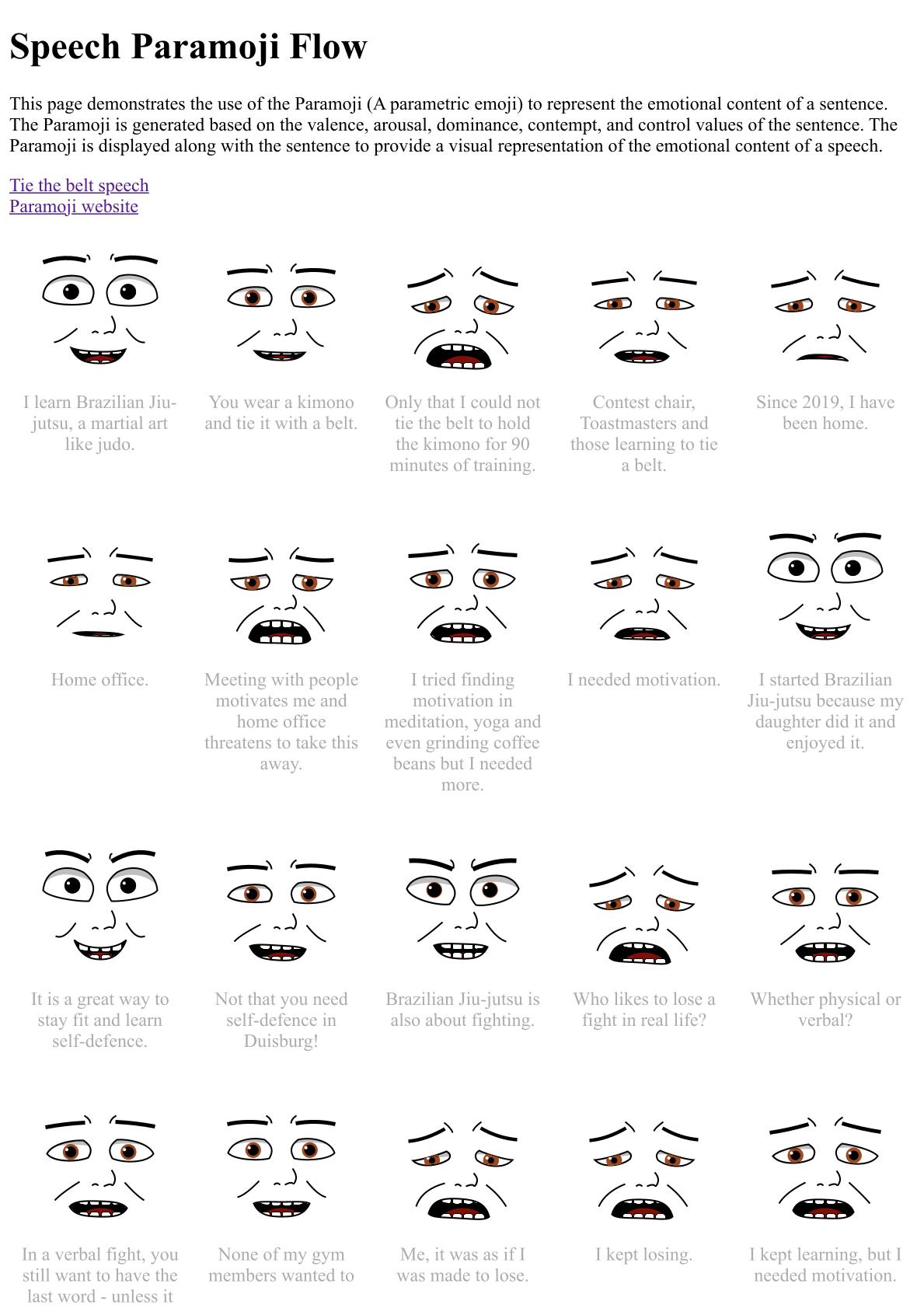

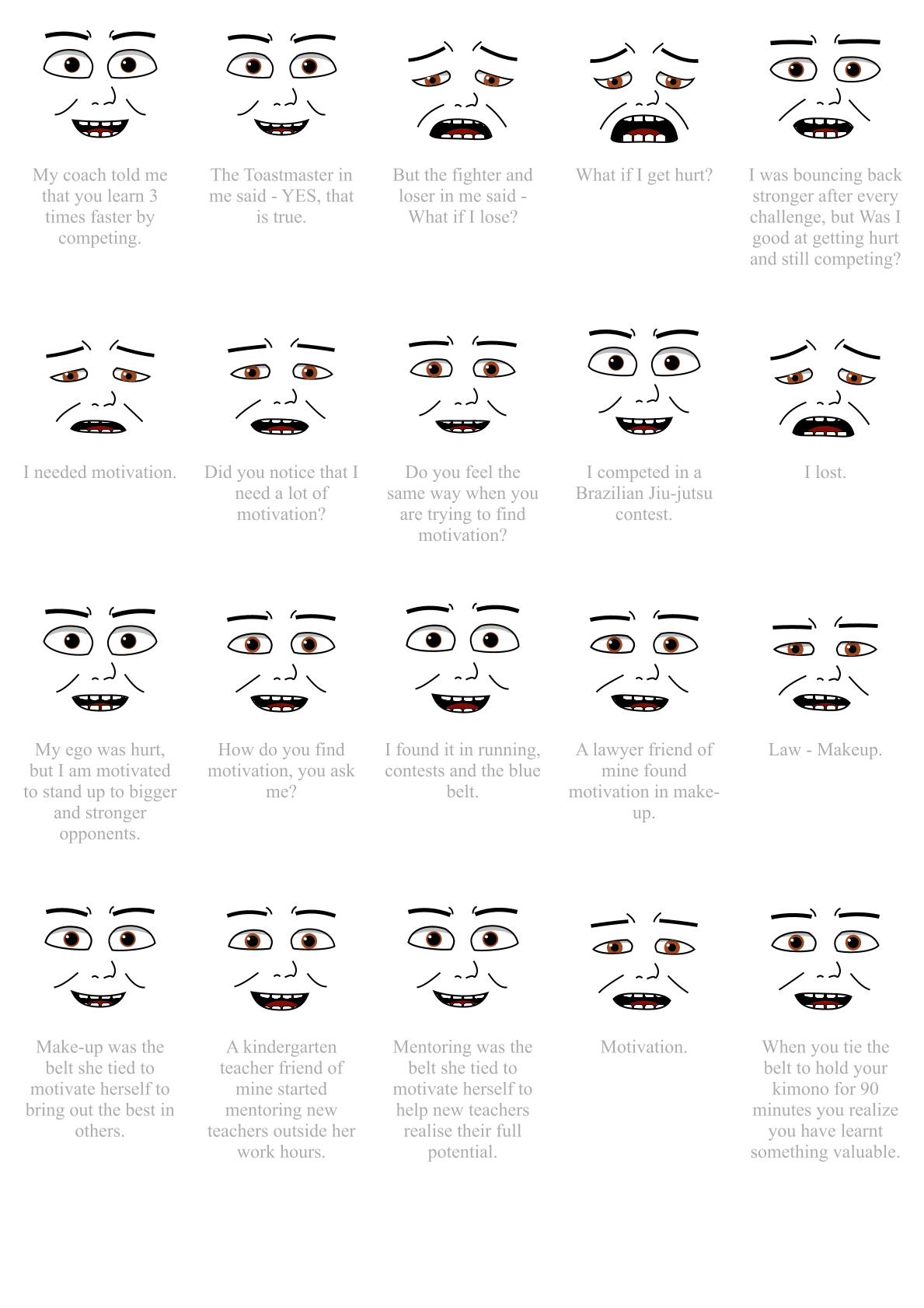
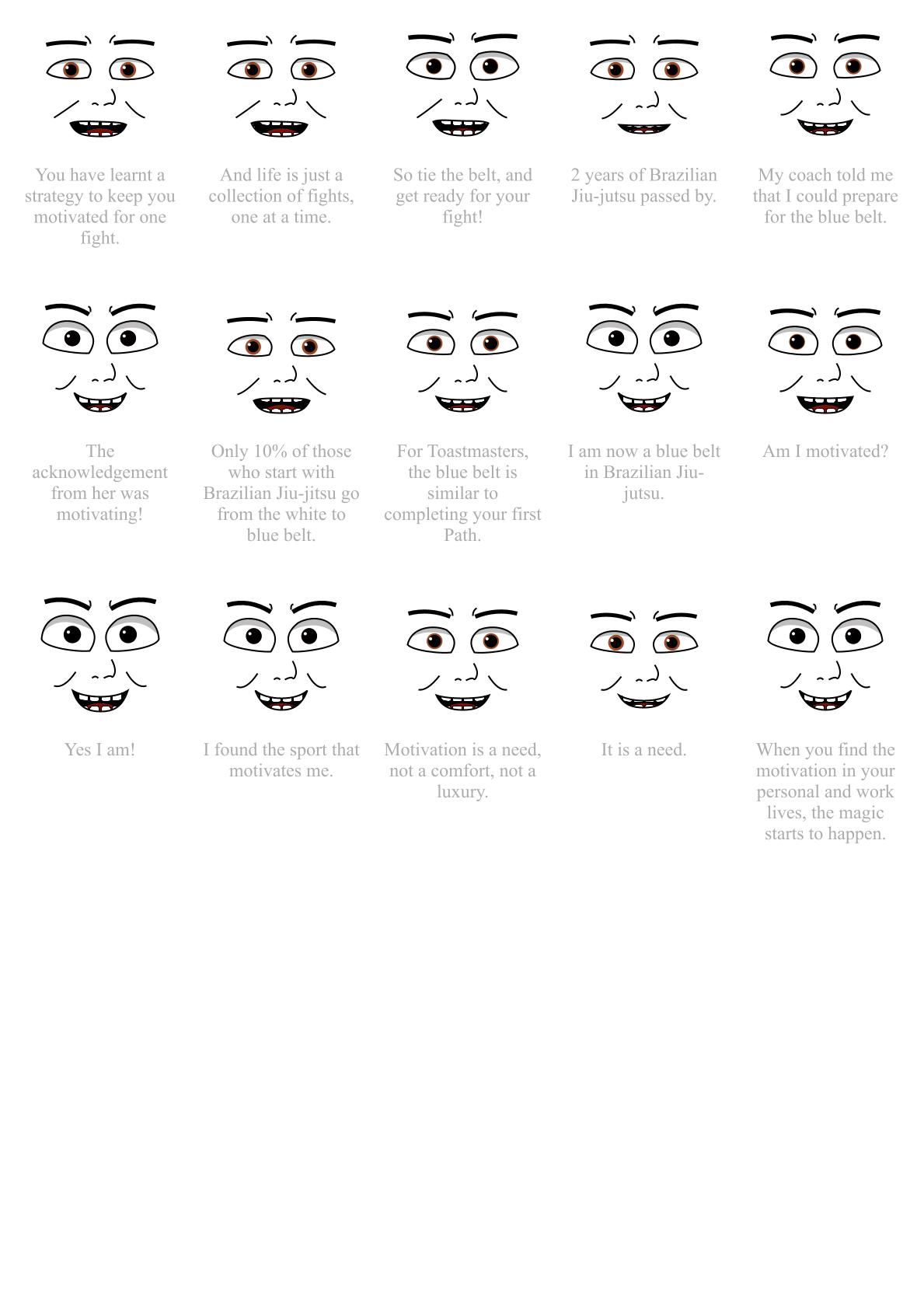
I love crafting and making speeches.
I love tools which analyse and give insights into my speeches.
Last week I attended a AI Innovators meetup organized at KI Reply in Munich. One of the sessions was “Human emotions at scale” presented by Stefan Dirnstorfer.
I liked the way he compared the tweets and opinions of Trump and Biden before and after the debate, Rishi and Keir before and after the election results using Paramojis.
“A paramoji is a parametric smiley face that represents facial expressions on continuous scales” – Stefan Dirnstorfer
I was wondering if I could follow the emotional rollcoaster that a speech takes the audience through.
Using ChatGPT, GitHub Copilot and the PHP code snippet from Stefan I wrote a small application which created the above Paramoji Speech Flow.
I like the way in Page 1, you can note that emotionally in every 5 sentences there is happy and sad emotion (deliberately simplifying emotions for discussion)
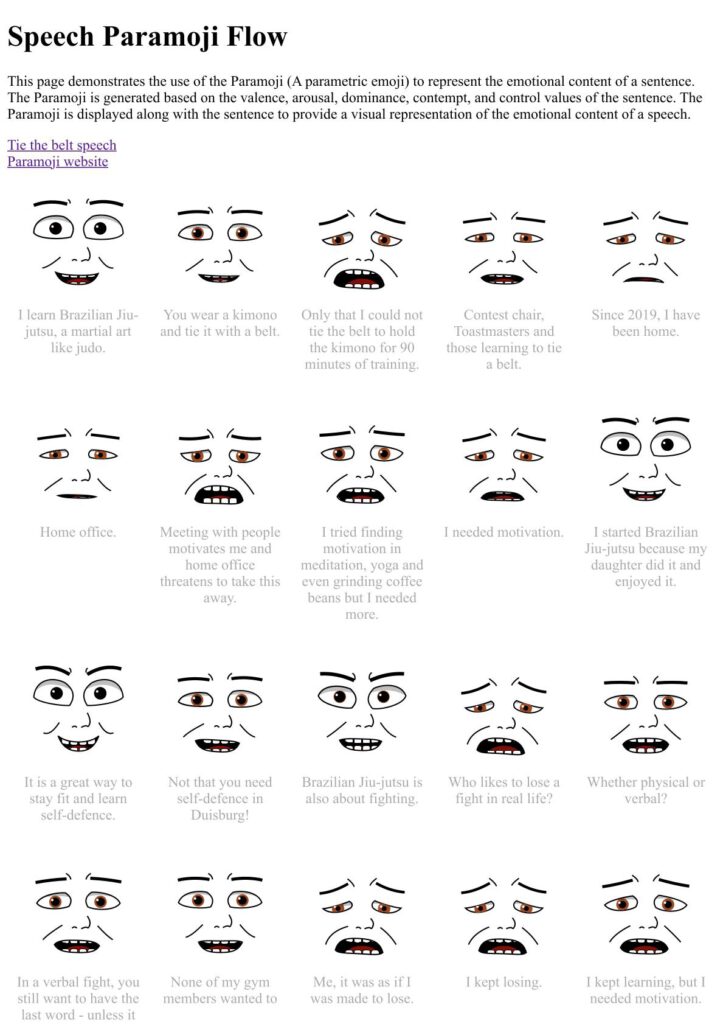
I like the way in Page 4, you can notice the excitement in the mouth and eye gestures.
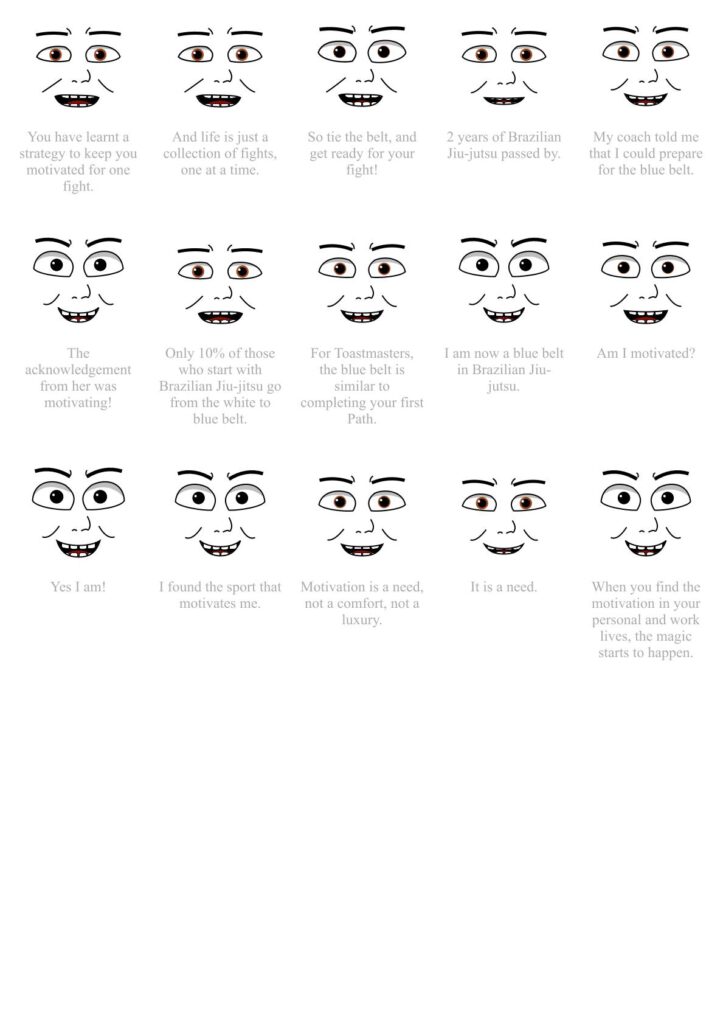
How do you analyse and learn from insights from your speeches?
Links:
[HYBRID] AI in Software development lifecycle, Wed, Jul 10, 2024, 6:00 PM | Meetup
-
Quality Club Meetings
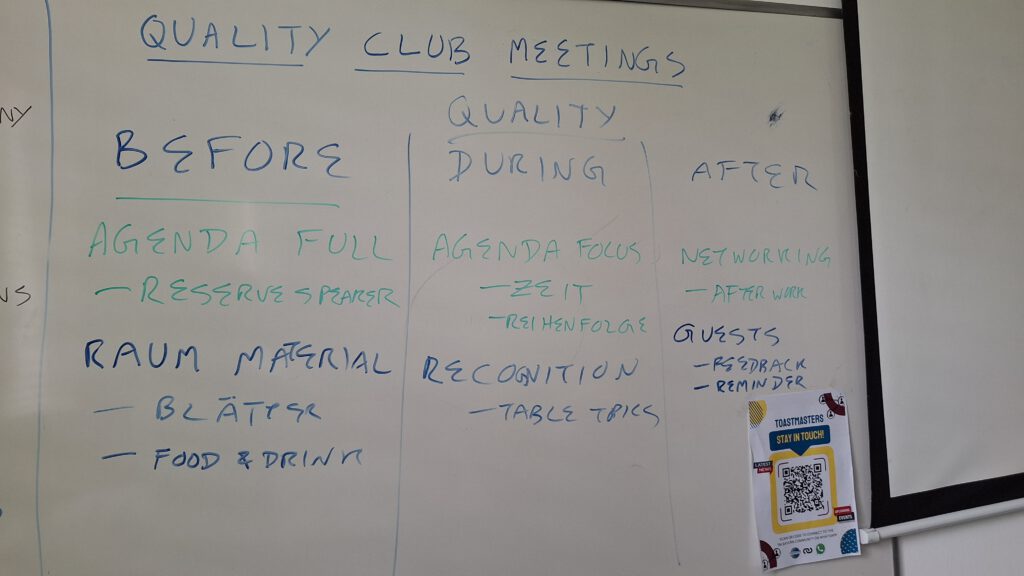
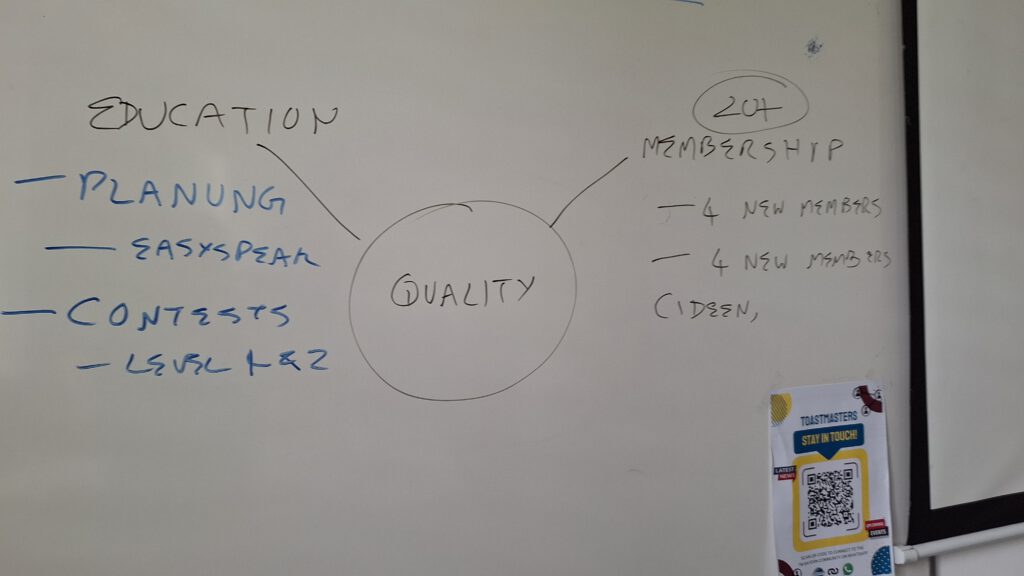
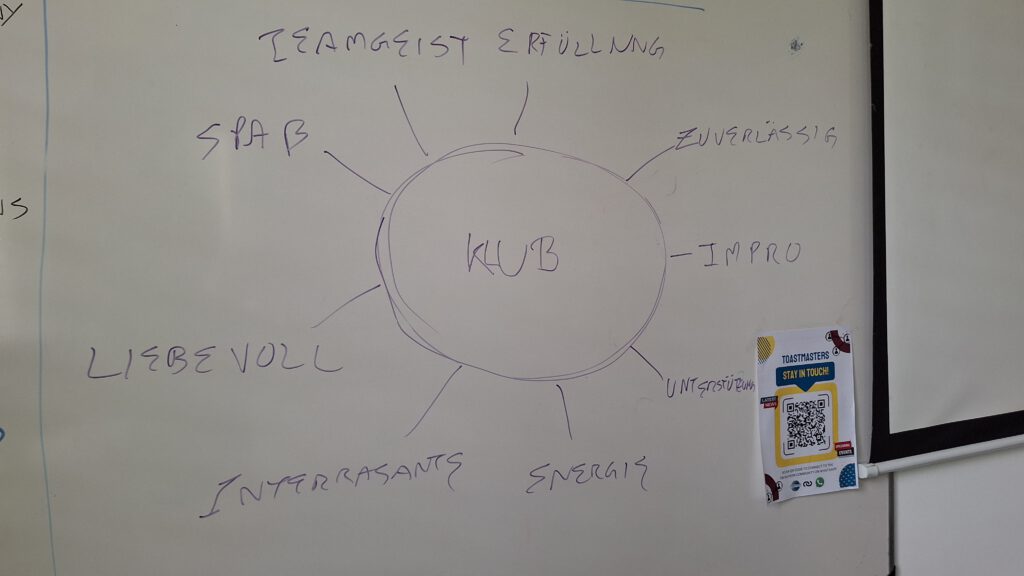


Why does “Made in Germany” bring up such positive feelings from the audience?
We heard “High quality”, “Predictable”, “Reliable”, “Manufactured goods”, “Good beer”, “Changeable” and “Long-lasting”
We switched “Made in Germany” with the “Club” and asked members to talk about what came to their minds?
We heard “Team spirit”, “Fulfillment”, “Improvisation”, “Support”, “Energy”, “Loving” and “Joy”.
Quality is a perception. This perception is created by the members of the club, members of a product, members of a service. This perception can be molded to be something that is remembered for generations.
We delved into how we can change the perception of Quality before, during and after meetings and we had a lot of input from the officers.
By having a full agenda and setting up the stage we could increase the quality before the meeting even starts.
By focussing on the Agenda and ensuring that it runs sequentially and on time we can exude Quality during a meeting.
By talking to guests after a meeting and helping them we can show the Quality in after meeting care.
All in all when the officers together with members do their bit before, during and after a meeting we can proudly the quality of the club is “Made in Germany”
Links:
1111 Distinguished Club Program (toastmasterscdn.azureedge.net)
-
GPT4All for Insights into speeches
A lot of speakers have made speeches over the years and a have quite a collection of them.
What are we doing with these speeches?
Are we mining them for insights into the messages that they had?
Are we dissecting to find common messages that we are comfortable and good at talking about?
I played around with GPT4All with my district level speeches and tried to understand the message from one speech and the common message across multiple speeches.
Check out the YouTube video and see if you would try something similar with your speeches?
Link: GPT4All
-
Prompt for Contest speech
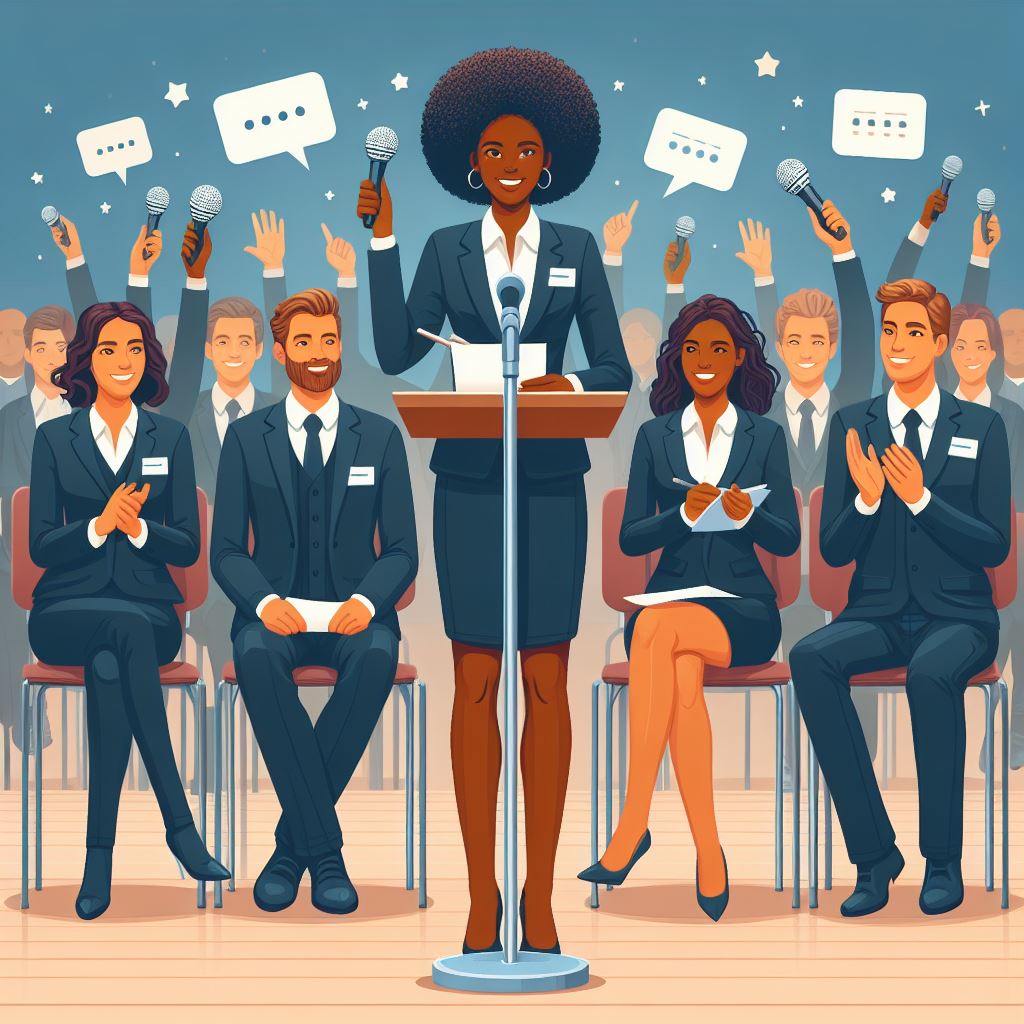
Can you use AI to impove your speech?
Yes, you can!
I used the Judging ballot criteria on Content from Toastmasters International and connected it with ChatGPT from OpenAI to get some ideas to improve the speech. Try it out and see how it works
Here is a simple prompt to do so:
You are a judge for the World Champion of Public Speaking in Toastmasters with these criteria:
Speech Development is the way the speaker puts ideas together so the audience can understand them. The speech is structured around a purpose, and this structure must include an opening, body and conclusion. A good speech immediately engages the audience’s attention and then moves forward toward a sig nificant conclusion. This development of the speech structure is supported by relevant examples and illustrations, facts and figures, delivered with such smoothness that they blend into the framework of the speech to present the audience with a unified whole.
Effectiveness is measured in part by the audience’s reception of the speech, but a large part is your subjective judgment of how the speech came across. You should ask yourself such questions as “Was I able to determine the speaker’s purpose?” “Did the speech relate directly to that purpose?” “Was the audience’s interest held by the speaker?” “Was this speech subject appropriate for this particular audience?”
Speech Value justifies the act of speaking. The speaker has a responsibility to say something meaningful and original to the audience. The listeners should feel the speaker has made a contribution to their thinking. The ideas should be important ones, although this does not preclude a humorous presentation of them.
Use the above criteria to provide feedback on the speech below in two parts:
1. What was good with examples
2. What may be improved with suggestions
<<Insert speech text here>>
Links:
ChatGPT: https://chat.openai.com/
Copilot: https://copilot.microsoft.com/ (Use the Notebook for more than 2000 words)
Gemini: https://gemini.google.com/
Toastmasters International -International Speech Contest Judge’s Guide and Ballot
-
Sky lantern
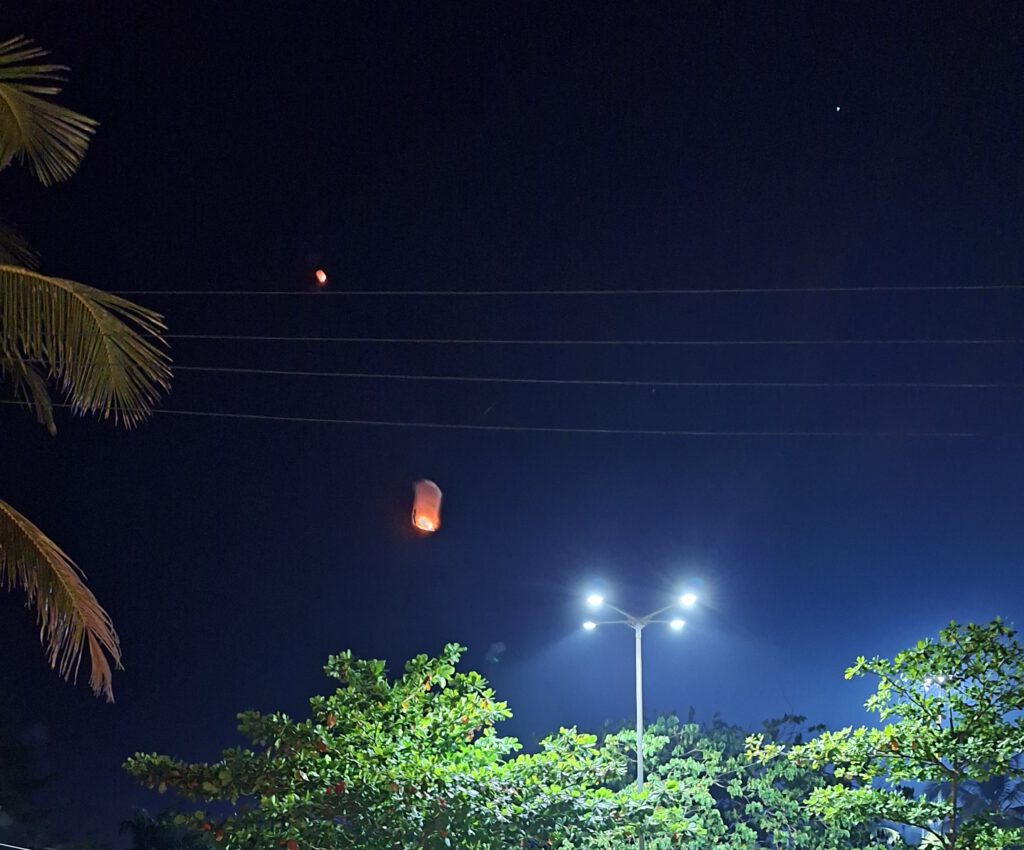
This New Year, I let a Sky lantern fly next to the sandy beaches of Goa to the sound of fireworks.
A Sky lantern requires a few steps before it can fly.
- You need to fix the burning camphor like substance to the base of the lamp.
- One guy in front of me broke the burning disc and had to start again with another disc
- You need to open up the lamp on all four sides so that the fire does not get to the sides of the lamp.
- Another guy did not open the sides and they burnt the sides and he had to start again
- You need to wait for the warm air to build up in the lamp
- Another impatient guy could not wait for 2 minutes and let it fly only to have the lamp come down crashing and he had to start again
I watched all these guys and thought I had learnt all the ways to fail and managed to get that lamp ready!
But my lamp would not rise up.
A friend walked up to me and told me to give it a nudge upwards and let it fly.
I did just that and there the Sky lantern raised up and started flying.
Sometimes we are like Sky lanterns.
There are so many things that need to be right for us to fly.
But when all the conditions are right, you might need that little nudge to get flying.
Do you need a nudge to kick start your speaking journey and be a Sky lantern?
Let me help you shine as a speaker in 2024!
Give me a call or contact me for individual and team coaching.
- You need to fix the burning camphor like substance to the base of the lamp.
-

5 years to learn Motivational Strategies
It took me 5 years from 2018 till 2023 to complete my Toastmasters learning path on “Motivational Strategies”.
I reflected on this path this week in my club and I shared my Personal and Toastmasters achievements in this time period.
The two personal achievements I shared were getting my blue belt in Brazilian Ju-Jitsu (2023) and running 5K with the Couch to 5K (2023) program.
The Toastmasters achievement I shared was winning the International Speech Contest in English at the district level in 2022 (District 95 – Germany, Norway, Sweden and Denmark).
I needed motivation at different points during these 5 years. I got it from my daughter, BJJ coaches (Laurien and Alex), BJJ sparring partners (Basti, Dimi, Norbert and others) and Toastmasters members.
Motivation is not an easy thing to have.
- One needs strategies to have it.
Motivation is not an easy thing to keep.
- One needs strategies to keep it.
Listen me out for around 12 minutes to hear what motivated me and what kept me motivated 🙂
Links:
TLA – Deine Kampfsport und Yoga Schule im Münchner Norden (team-laurien-alex.de)
Get running with Couch to 5K – NHS (www.nhs.uk)
(1) Motivational Strategies | Reflection on Path – YouTube
Toastmasters International -Pathways Motivational Strategies Path
-
Learning 3Cs of Comedy with Mel

Yesterday I attended a humour workshop run by Mel at the Munich Prostmasters Toastmasters club.
I have always been amazed by the energy that Mel brings to the stage and his ability to break the ice with audience from different cultures. Yesterday was no different.
He discussed the different comedy structures with the audience. They came up quite a few of them.

You knew that you were dealing with room of eager learners of humour!
Connection
I liked the part where he explained how to set up the premise, step 1 (positive), step 2 (very positive) and step 3 (negative). My group came up this joke:
“The United States has produced amazing Presidents.
Abraham Lincolm with the Gettysburg address
John F Kennedy with ‘Ich bin ein Berliner’
and
Donald Trump with ‘Make America great again’”
We did not get many laughs. We had complicated the simple structure. The premise was that the USA had produced amazing Presidents. The step 1 and 2 was complex with the name of the President and the speech they were famous for. Step 3 was very predicatable so it did not get many laughs.
We realised that writing humour is NOT easy. It was interesting to see the different groups trying their hand adding humour with the “rule of three” structure.
Confidence
This was the first time I heard about Uptalking and Downtalking.
Mel helped us practice multiple times with Uptalk and Downtalk. It was interesting to see how using conscious intonation when needed made such a big difference to the confidence projected.
Convincing
Mel helped us understand the value behind calling a room. That is addressing a disturbance in the room and not just assuming that it did not happen.
We had a lot of fun disturbing the speakers while they were talking and waiting for them to address us and get us to stop.
The other strategies of Smiling, using Names, asking questions were also used by the speakers on stage.
All in all, I learnt the 3Cs of Comedy from Mel yesterday and I am raring to give it a go with my next speech!
Links:
About | Comedy Club Munich (comedy-club-munich.com)
Get your book! (comedybooks-melkelly.com)
What Is Uptalk? Why, When, & How to Stop Doing It (yoodli.ai)
